brake fluid YAMAHA JOG50R 2012 Owners Manual
[x] Cancel search | Manufacturer: YAMAHA, Model Year: 2012, Model line: JOG50R, Model: YAMAHA JOG50R 2012Pages: 76, PDF Size: 1.51 MB
Page 6 of 76
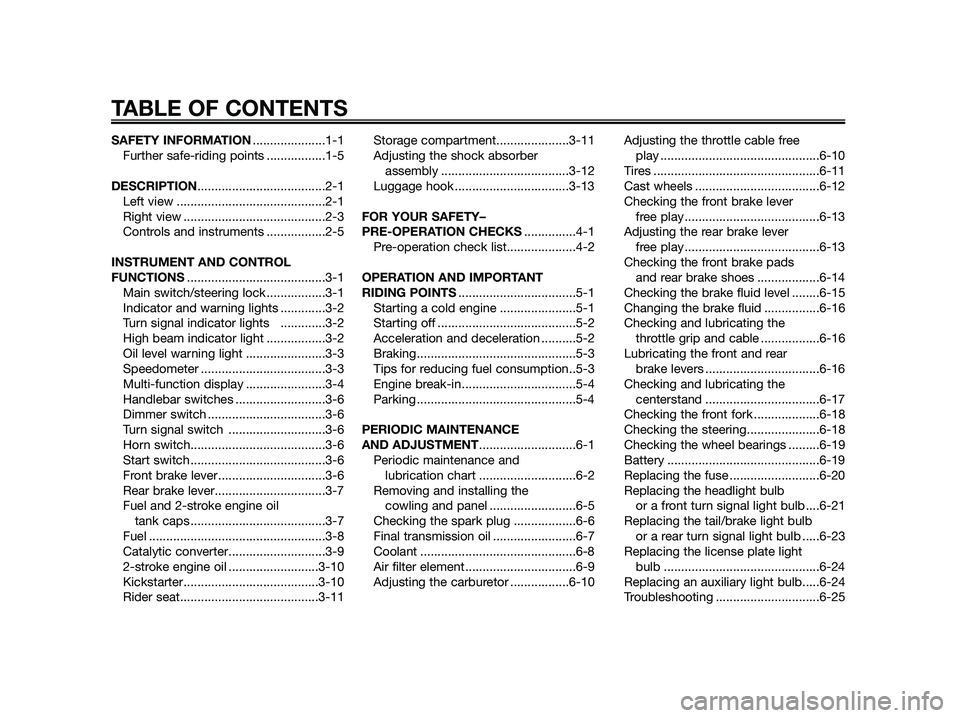
SAFETY INFORMATION.....................1-1
Further safe-riding points .................1-5
DESCRIPTION.....................................2-1
Left view ...........................................2-1
Right view .........................................2-3
Controls and instruments .................2-5
INSTRUMENT AND CONTROL
FUNCTIONS........................................3-1
Main switch/steering lock .................3-1
Indicator and warning lights .............3-2
Turn signal indicator lights .............3-2
High beam indicator light .................3-2
Oil level warning light .......................3-3
Speedometer ....................................3-3
Multi-function display .......................3-4
Handlebar switches ..........................3-6
Dimmer switch ..................................3-6
Turn signal switch ............................3-6
Horn switch.......................................3-6
Start switch .......................................3-6
Front brake lever...............................3-6
Rear brake lever................................3-7
Fuel and 2-stroke engine oil
tank caps .......................................3-7
Fuel ...................................................3-8
Catalytic converter............................3-9
2-stroke engine oil ..........................3-10
Kickstarter.......................................3-10
Rider seat........................................3-11Storage compartment.....................3-11
Adjusting the shock absorber
assembly .....................................3-12
Luggage hook .................................3-13
FOR YOUR SAFETY–
PRE-OPERATION CHECKS...............4-1
Pre-operation check list....................4-2
OPERATION AND IMPORTANT
RIDING POINTS..................................5-1
Starting a cold engine ......................5-1
Starting off ........................................5-2
Acceleration and deceleration ..........5-2
Braking..............................................5-3
Tips for reducing fuel consumption..5-3
Engine break-in.................................5-4
Parking ..............................................5-4
PERIODIC MAINTENANCE
AND ADJUSTMENT............................6-1
Periodic maintenance and
lubrication chart ............................6-2
Removing and installing the
cowling and panel .........................6-5
Checking the spark plug ..................6-6
Final transmission oil ........................6-7
Coolant .............................................6-8
Air filter element ................................6-9
Adjusting the carburetor .................6-10Adjusting the throttle cable free
play ..............................................6-10
Tires ................................................6-11
Cast wheels ....................................6-12
Checking the front brake lever
free play .......................................6-13
Adjusting the rear brake lever
free play .......................................6-13
Checking the front brake pads
and rear brake shoes ..................6-14
Checking the brake fluid level ........6-15
Changing the brake fluid ................6-16
Checking and lubricating the
throttle grip and cable .................6-16
Lubricating the front and rear
brake levers .................................6-16
Checking and lubricating the
centerstand .................................6-17
Checking the front fork ...................6-18
Checking the steering.....................6-18
Checking the wheel bearings .........6-19
Battery ............................................6-19
Replacing the fuse ..........................6-20
Replacing the headlight bulb
or a front turn signal light bulb ....6-21
Replacing the tail/brake light bulb
or a rear turn signal light bulb .....6-23
Replacing the license plate light
bulb .............................................6-24
Replacing an auxiliary light bulb.....6-24
Troubleshooting ..............................6-25
TABLE OF CONTENTS
Page 32 of 76
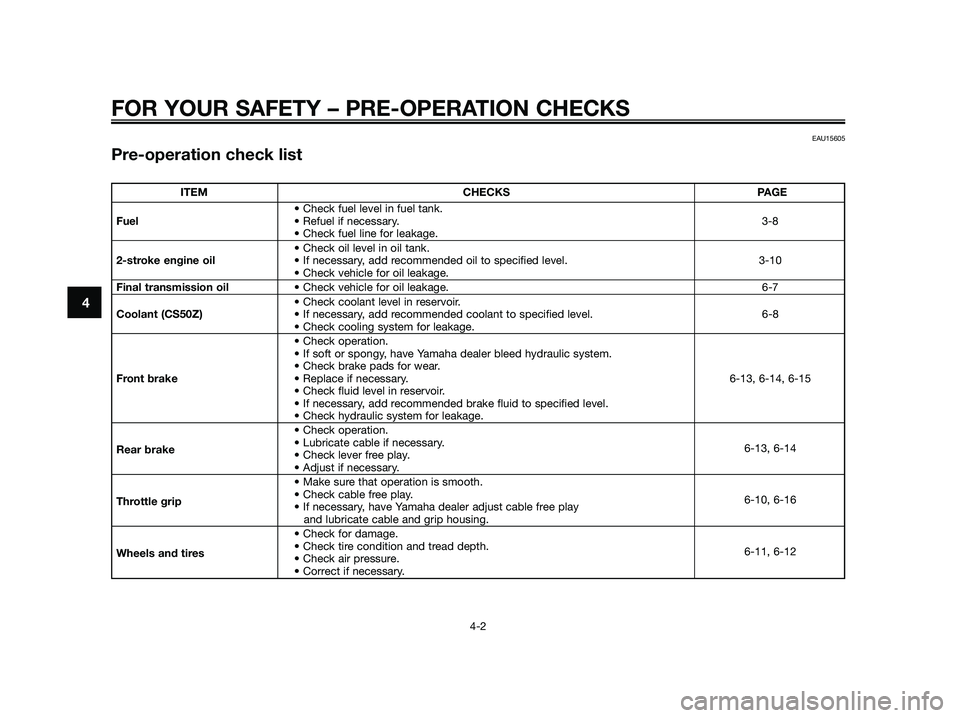
FOR YOUR SAFETY – PRE-OPERATION CHECKS
4-2
4
EAU15605
Pre-operation check list
ITEM CHECKS PAGE
• Check fuel level in fuel tank.
Fuel• Refuel if necessary.3-8
• Check fuel line for leakage.
• Check oil level in oil tank.
2-stroke engine oil• If necessary, add recommended oil to specified level. 3-10
• Check vehicle for oil leakage.
Final transmission oil• Check vehicle for oil leakage. 6-7
• Check coolant level in reservoir.
Coolant (CS50Z)• If necessary, add recommended coolant to specified level. 6-8
• Check cooling system for leakage.
• Check operation.
• If soft or spongy, have Yamaha dealer bleed hydraulic system.
• Check brake pads for wear.
Front brake• Replace if necessary. 6-13, 6-14, 6-15
• Check fluid level in reservoir.
• If necessary, add recommended brake fluid to specified level.
• Check hydraulic system for leakage.
• Check operation.
Rear brake• Lubricate cable if necessary.
• Check lever free play.6-13, 6-14
• Adjust if necessary.
• Make sure that operation is smooth.
Throttle grip• Check cable free play.
• If necessary, have Yamaha dealer adjust cable free play 6-10, 6-16
and lubricate cable and grip housing.
• Check for damage.
Wheels and tires• Check tire condition and tread depth.
• Check air pressure.6-11, 6-12
• Correct if necessary.
Page 39 of 76
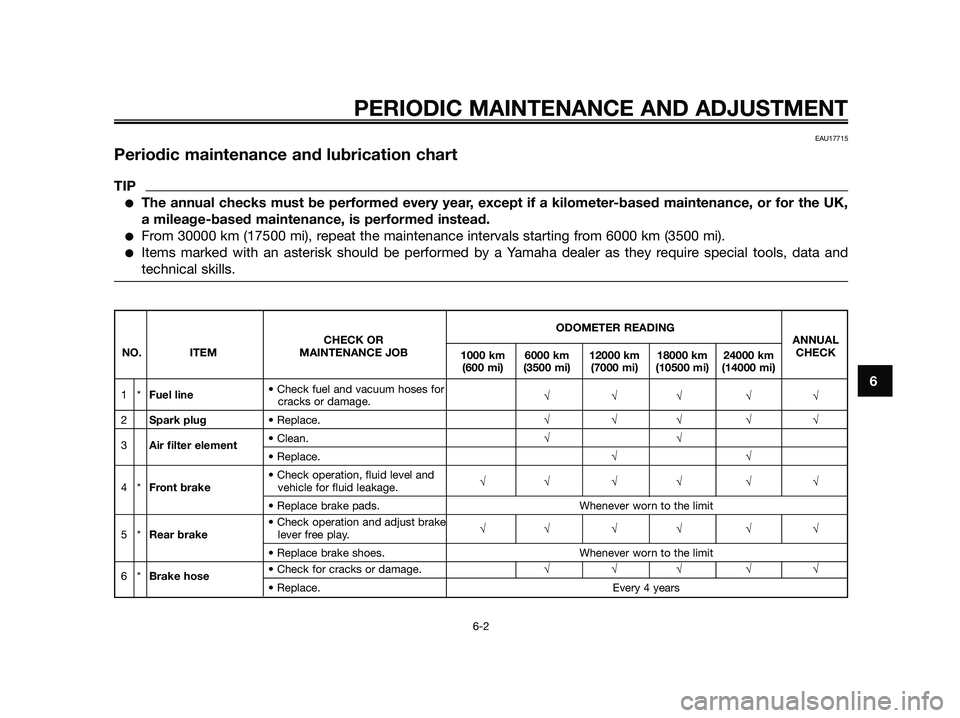
PERIODIC MAINTENANCE AND ADJUSTMENT
6-2
6
EAU17715
Periodic maintenance and lubrication chart
TIP
●The annual checks must be performed every year, except if a kilometer-based maintenance, or for the UK,
a mileage-based maintenance, is performed instead.
●From 30000 km (17500 mi), repeat the maintenance intervals starting from 6000 km (3500 mi).
●Items marked with an asterisk should be performed by a Yamaha dealer as they require special tools, data and
technical skills.
ODOMETER READING
CHECK OR ANNUAL
NO. ITEM MAINTENANCE JOB
1000 km 6000 km 12000 km 18000 km 24000 kmCHECK
(600 mi) (3500 mi) (7000 mi) (10500 mi) (14000 mi)
1*Fuel line• Check fuel and vacuum hoses for
cracks or damage.√√√ √√
2Spark plug• Replace.√√√ √√
3Air filter element• Clean.√√• Replace.√√
• Check operation, fluid level and
4*Front brakevehicle for fluid leakage.√√ √√ √ √
• Replace brake pads. Whenever worn to the limit
• Check operation and adjust brake
5*Rear brakelever free play.√√ √√ √ √
• Replace brake shoes. Whenever worn to the limit
6*Brake hose• Check for cracks or damage.√√√ √√
• Replace. Every 4 years
Page 41 of 76
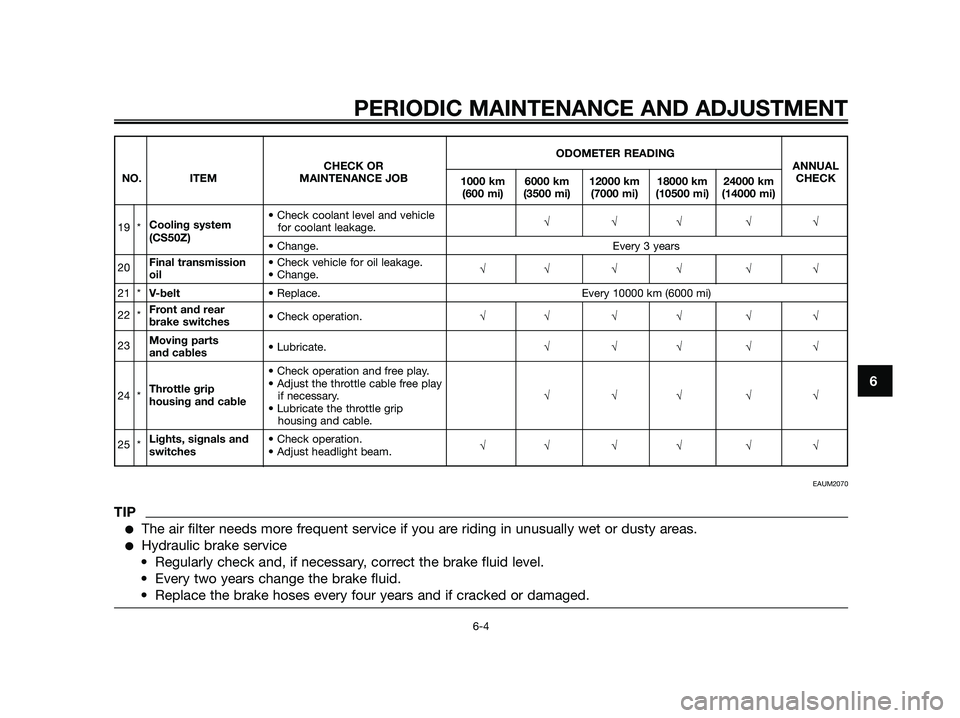
PERIODIC MAINTENANCE AND ADJUSTMENT
6-4
6
ODOMETER READING
CHECK OR ANNUAL
NO. ITEM MAINTENANCE JOB
1000 km 6000 km 12000 km 18000 km 24000 kmCHECK
(600 mi) (3500 mi) (7000 mi) (10500 mi) (14000 mi)
• Check coolant level and vehicle
19 *Cooling system
for coolant leakage.√√√ √√(CS50Z)
• Change. Every 3 years
20Final transmission • Check vehicle for oil leakage.
oil• Change.√√ √√ √ √
21 *V-belt• Replace. Every 10000 km (6000 mi)
22 *Front and rear
brake switches• Check operation.√√ √√ √ √
23Moving parts
and cables• Lubricate.√√√ √√
• Check operation and free play.
Throttle grip• Adjust the throttle cable free play
24 * if necessary.√√√ √√
housing and cable
• Lubricate the throttle grip
housing and cable.
25 *Lights, signals and • Check operation.
switches• Adjust headlight beam.√√ √√ √ √
EAUM2070
TIP
●The air filter needs more frequent service if you are riding in unusually wet or dusty areas.
●Hydraulic brake service
• Regularly check and, if necessary, correct the brake fluid level.
• Every two years change the brake fluid.
• Replace the brake hoses every four years and if cracked or damaged.
Page 52 of 76
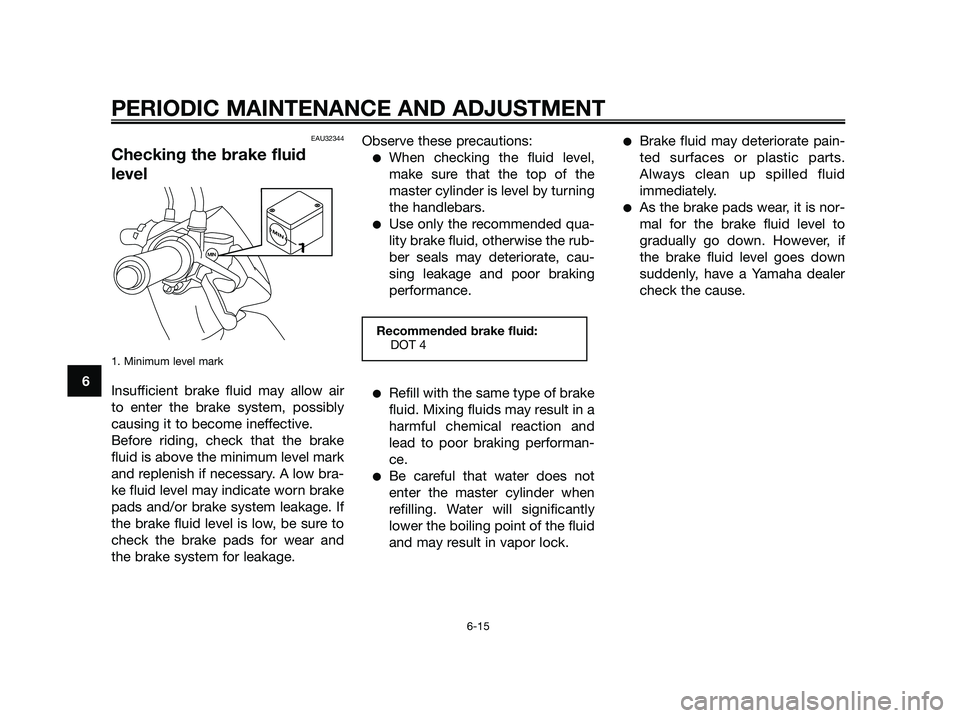
EAU32344
Checking the brake fluid
level
1. Minimum level mark
Insufficient brake fluid may allow air
to enter the brake system, possibly
causing it to become ineffective.
Before riding, check that the brake
fluid is above the minimum level mark
and replenish if necessary. A low bra-
ke fluid level may indicate worn brake
pads and/or brake system leakage. If
the brake fluid level is low, be sure to
check the brake pads for wear and
the brake system for leakage.Observe these precautions:
●When checking the fluid level,
make sure that the top of the
master cylinder is level by turning
the handlebars.
●Use only the recommended qua-
lity brake fluid, otherwise the rub-
ber seals may deteriorate, cau-
sing leakage and poor braking
performance.
●Refill with the same type of brake
fluid. Mixing fluids may result in a
harmful chemical reaction and
lead to poor braking performan-
ce.
●Be careful that water does not
enter the master cylinder when
refilling. Water will significantly
lower the boiling point of the fluid
and may result in vapor lock.
●Brake fluid may deteriorate pain-
ted surfaces or plastic parts.
Always clean up spilled fluid
immediately.
●As the brake pads wear, it is nor-
mal for the brake fluid level to
gradually go down. However, if
the brake fluid level goes down
suddenly, have a Yamaha dealer
check the cause.
Recommended brake fluid:
DOT 4
M
IN
1
PERIODIC MAINTENANCE AND ADJUSTMENT
6-15
6
Page 53 of 76
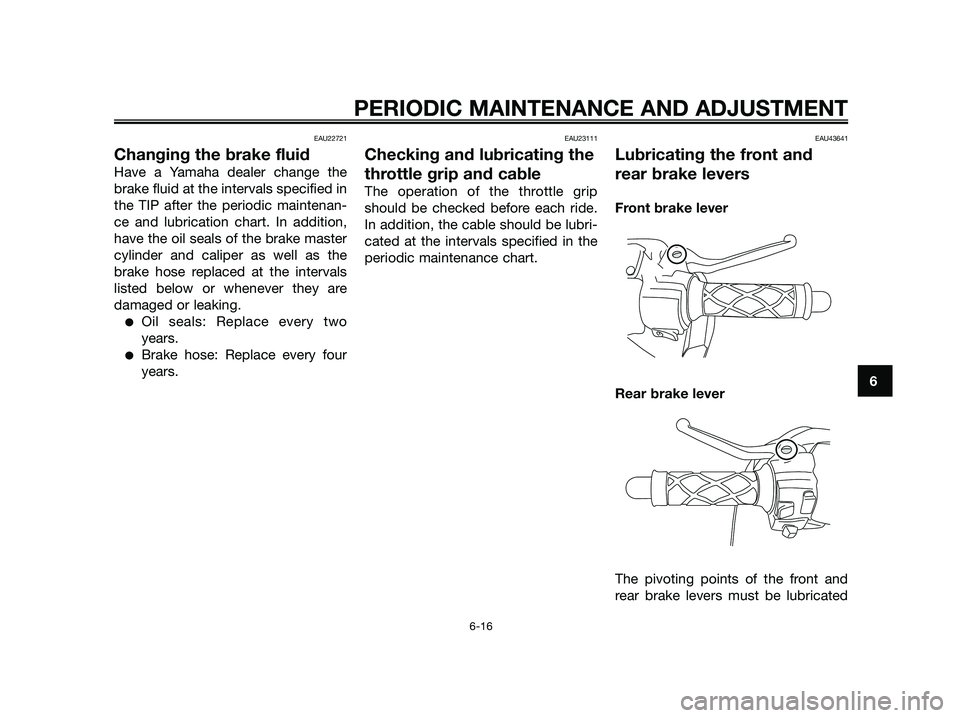
EAU22721
Changing the brake fluid
Have a Yamaha dealer change the
brake fluid at the intervals specified in
the TIP after the periodic maintenan-
ce and lubrication chart. In addition,
have the oil seals of the brake master
cylinder and caliper as well as the
brake hose replaced at the intervals
listed below or whenever they are
damaged or leaking.
●Oil seals: Replace every two
years.
●Brake hose: Replace every four
years.
EAU23111
Checking and lubricating the
throttle grip and cable
The operation of the throttle grip
should be checked before each ride.
In addition, the cable should be lubri-
cated at the intervals specified in the
periodic maintenance chart.
EAU43641
Lubricating the front and
rear brake levers
Front brake lever
Rear brake lever
The pivoting points of the front and
rear brake levers must be lubricated
PERIODIC MAINTENANCE AND ADJUSTMENT
6-16
6
Page 66 of 76
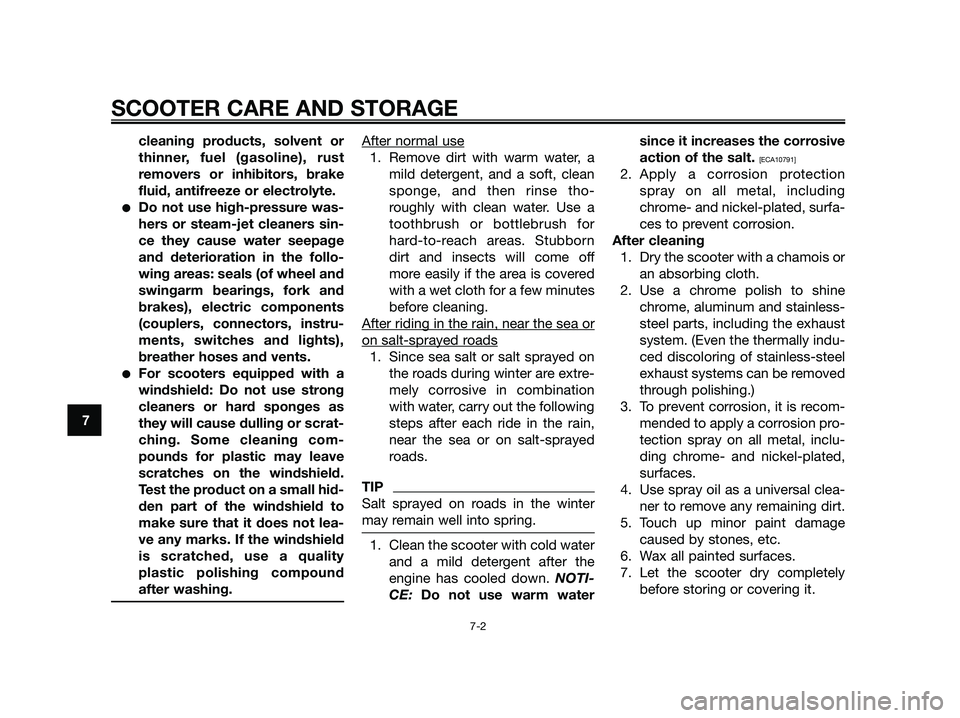
cleaning products, solvent or
thinner, fuel (gasoline), rust
removers or inhibitors, brake
fluid, antifreeze or electrolyte.
●Do not use high-pressure was-
hers or steam-jet cleaners sin-
ce they cause water seepage
and deterioration in the follo-
wing areas: seals (of wheel and
swingarm bearings, fork and
brakes), electric components
(couplers, connectors, instru-
ments, switches and lights),
breather hoses and vents.
●For scooters equipped with a
windshield: Do not use strong
cleaners or hard sponges as
they will cause dulling or scrat-
ching. Some cleaning com-
pounds for plastic may leave
scratches on the windshield.
Test the product on a small hid-
den part of the windshield to
make sure that it does not lea-
ve any marks. If the windshield
is scratched, use a quality
plastic polishing compound
after washing.
After normal use
1. Remove dirt with warm water, a
mild detergent, and a soft, clean
sponge, and then rinse tho-
roughly with clean water. Use a
toothbrush or bottlebrush for
hard-to-reach areas. Stubborn
dirt and insects will come off
more easily if the area is covered
with a wet cloth for a few minutes
before cleaning.
After riding in the rain, near the sea or
on salt-sprayed roads
1. Since sea salt or salt sprayed on
the roads during winter are extre-
mely corrosive in combination
with water, carry out the following
steps after each ride in the rain,
near the sea or on salt-sprayed
roads.
TIP
Salt sprayed on roads in the winter
may remain well into spring.
1. Clean the scooter with cold water
and a mild detergent after the
engine has cooled down. NOTI-
CE:Do not use warm watersince it increases the corrosive
action of the salt.
[ECA10791]
2. Apply a corrosion protection
spray on all metal, including
chrome- and nickel-plated, surfa-
ces to prevent corrosion.
After cleaning
1. Dry the scooter with a chamois or
an absorbing cloth.
2. Use a chrome polish to shine
chrome, aluminum and stainless-
steel parts, including the exhaust
system. (Even the thermally indu-
ced discoloring of stainless-steel
exhaust systems can be removed
through polishing.)
3. To prevent corrosion, it is recom-
mended to apply a corrosion pro-
tection spray on all metal, inclu-
ding chrome- and nickel-plated,
surfaces.
4. Use spray oil as a universal clea-
ner to remove any remaining dirt.
5. Touch up minor paint damage
caused by stones, etc.
6. Wax all painted surfaces.
7. Let the scooter dry completely
before storing or covering it.
SCOOTER CARE AND STORAGE
7-2
7
Page 70 of 76
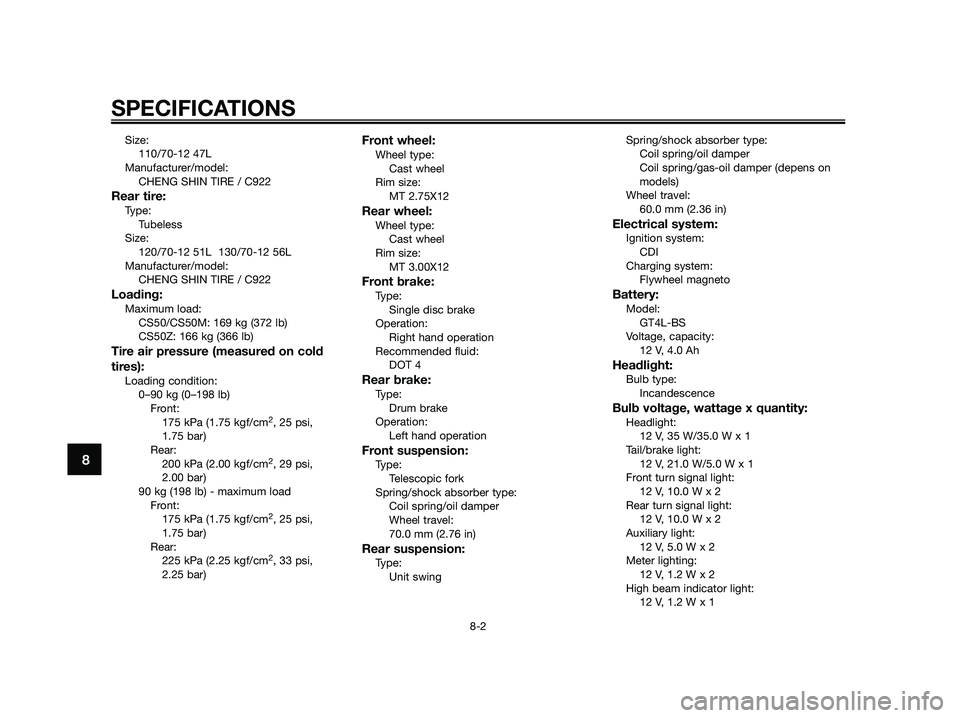
Size:
110/70-12 47L
Manufacturer/model:
CHENG SHIN TIRE / C922
Rear tire:
Type:
Tubeless
Size:
120/70-12 51L 130/70-12 56L
Manufacturer/model:
CHENG SHIN TIRE / C922
Loading:Maximum load:
CS50/CS50M: 169 kg (372 lb)
CS50Z: 166 kg (366 lb)
Tire air pressure (measured on cold
tires):
Loading condition:
0–90 kg (0–198 lb)
Front:
175 kPa (1.75 kgf/cm
2, 25 psi,
1.75 bar)
Rear:
200 kPa (2.00 kgf/cm
2, 29 psi,
2.00 bar)
90 kg (198 lb) - maximum load
Front:
175 kPa (1.75 kgf/cm
2, 25 psi,
1.75 bar)
Rear:
225 kPa (2.25 kgf/cm
2, 33 psi,
2.25 bar)
Front wheel:Wheel type:
Cast wheel
Rim size:
MT 2.75X12
Rear wheel:Wheel type:
Cast wheel
Rim size:
MT 3.00X12
Front brake:Type:
Single disc brake
Operation:
Right hand operation
Recommended fluid:
DOT 4
Rear brake:Type:
Drum brake
Operation:
Left hand operation
Front suspension:Type:
Telescopic fork
Spring/shock absorber type:
Coil spring/oil damper
Wheel travel:
70.0 mm (2.76 in)
Rear suspension:Type:
Unit swingSpring/shock absorber type:
Coil spring/oil damper
Coil spring/gas-oil damper (depens on
models)
Wheel travel:
60.0 mm (2.36 in)
Electrical system:Ignition system:
CDI
Charging system:
Flywheel magneto
Battery:Model:
GT4L-BS
Voltage, capacity:
12 V, 4.0 Ah
Headlight:Bulb type:
Incandescence
Bulb voltage, wattage x quantity:Headlight:
12 V, 35 W/35.0 W x 1
Tail/brake light:
12 V, 21.0 W/5.0 W x 1
Front turn signal light:
12 V, 10.0 W x 2
Rear turn signal light:
12 V, 10.0 W x 2
Auxiliary light:
12 V, 5.0 W x 2
Meter lighting:
12 V, 1.2 W x 2
High beam indicator light:
12 V, 1.2 W x 1
SPECIFICATIONS
8-2
8
Page 74 of 76

2-stroke engine oil ...................................3-10
AAcceleration and deceleration ...................5-2
Air filter element .........................................6-9
Auxiliary light bulb, replacing ...................6-24
BBattery......................................................6-19
Brake fluid level, checking .......................6-15
Brake fluid, changing ...............................6-16
Brake lever, front ........................................3-6
Brake lever, rear .........................................3-7
Brake levers, lubricating ..........................6-16
Brake pads and shoes, checking ............6-14
Braking .......................................................5-3
CCarburetor,adjusting.................................6-10
Care............................................................7-1
Catalytic converter .....................................3-9
Centerstand, checking and lubricating ....6-17
Coolant.......................................................6-8
Cowling and panel, removing
and installing............................................6-5
DDimmer switch ...........................................3-6
EEngine break-in ..........................................5-4
FFinal transmission oil .................................6-7
Front brake lever free play, checking.......6-13
Front fork, checking .................................6-18
Fuel ............................................................3-8
Fuel and 2-stroke engine oil tank caps .....3-7
Fuel consumption, tips for reducing ..........5-3
Fuse, replacing.........................................6-20
HHandlebar switches ...................................3-6
Headlight and front turn signal light
bulb, replacing .......................................6-21
High beam indicator light...........................3-2
Horn switch ................................................3-6
IIdentification numbers ...............................9-1
Indicator and warning lights ......................3-2
KKey identification number ..........................9-1
Kickstarter ................................................3-10
LLicense plate light bulb, replacing ...........6-24
Luggage hook ..........................................3-13
M
Main switch/steering lock ..........................3-1
Matte color, caution ...................................7-1
Model label ................................................9-2
Multi-function display ................................3-4
OOil level warning light .................................3-3
PParking .......................................................5-4
Part locations .............................................1-5
Periodic maintenance and lubrication
chart .........................................................6-2
Pre-operation check list .............................4-2
RRear brake lever free play, adjusting .......6-13
Rider seat .................................................3-11
SSafe-riding points.......................................1-5
Safety information ......................................1-1Shock absorber assembly, adjusting.......3-12
Spark plug, checking .................................6-6
Specifications.............................................7-3
Speedometer .............................................3-3
Start switch ................................................3-6
Starting a cold engine ................................5-1
Starting off .................................................5-2
Steering, checking ...................................6-18
Storage.......................................................7-3
Storage compartment ..............................3-11
TTail/brake light bulb or rear turn signal
light bulb, replacing ...............................6-23
Throttle cable free play, adjusting ............6-10
Throttle grip and cable, checking and
lubricating ..............................................6-16
Tires .........................................................6-11
Troubleshooting .......................................6-25
Troubleshooting charts ............................6-26
Turn signal indicator lights .........................3-2
Turn signal switch ......................................3-6
VVehicle identification number .....................9-1
WWheel bearings, checking........................6-19
Wheels .....................................................6-12
INDEX